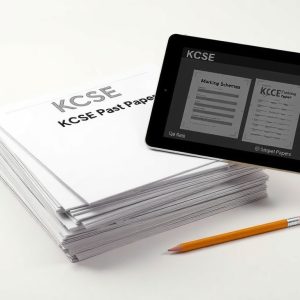Description
The document is a Kiswahili examination paper, specifically “KCSE MOCK-KISWAHILI PAPER 2,” designed for students in Kenya. It comprises various sections that assess different aspects of the Kiswahili language, including comprehension, summary writing, language usage, and sociolinguistics. Below is a comprehensive overview of the document’s structure and content:
General Structure
- Header Information:
- Contains details for the candidate, including name, number, and class.
- Specifies the paper’s title, subject (Kiswahili), date, and time allotted for the exam (2½ hours).
- Instructions:
- Candidates are instructed to fill in their personal details and sign the paper.
- Emphasizes the importance of answering all questions and ensuring that all pages are printed correctly.
- Scoring Breakdown:
- Clearly outlines the marks allocated to each question and section, totaling to 100 marks.
Content Overview
- Section 1: UFAHAMU (Comprehension) – 15 Marks
- Candidates are required to read a passage discussing the role of technology in enhancing security against crime.
- The passage explains both the benefits and potential dangers of technological advancements in law enforcement.
- Questions following the passage prompt students to analyze and extract information regarding:
- The challenges faced by law enforcement in combating crime.
- The impact of technology on transportation security.
- The role of surveillance technology in ensuring justice.
- Section 2: MUHTASARI (Summary) – 15 Marks
- Candidates are asked to provide their opinion on terrorism, highlighting the author’s views on its nature, implications, and the police’s inadequacies in addressing this issue.
- Additionally, students must summarize the last two paragraphs of the provided text, demonstrating the ability to condense information succinctly.
- Section 3: MATUMIZI YA LUGHA (Language Usage) – 40 Marks
- This section assesses students’ understanding of various linguistic concepts, including:
- Phonetics (characteristics of specific sounds).
- Sentence restructuring and transformation.
- Identification and classification of nouns and verbs.
- Sentence analysis using grammatical structures.
- Application of vocabulary and idiomatic expressions in sentences.
- This section assesses students’ understanding of various linguistic concepts, including:
- Section 4: ISIMUJAMII (Sociolinguistics) – 10 Marks
- Candidates are required to explain specific linguistic terms like ‘lingua franca,’ ‘register,’ ‘dialect,’ and ‘standard language.’
- This section also involves discussing the roles of the Kiswahili language in Kenya, highlighting its importance in communication and education.




Reviews
There are no reviews yet.